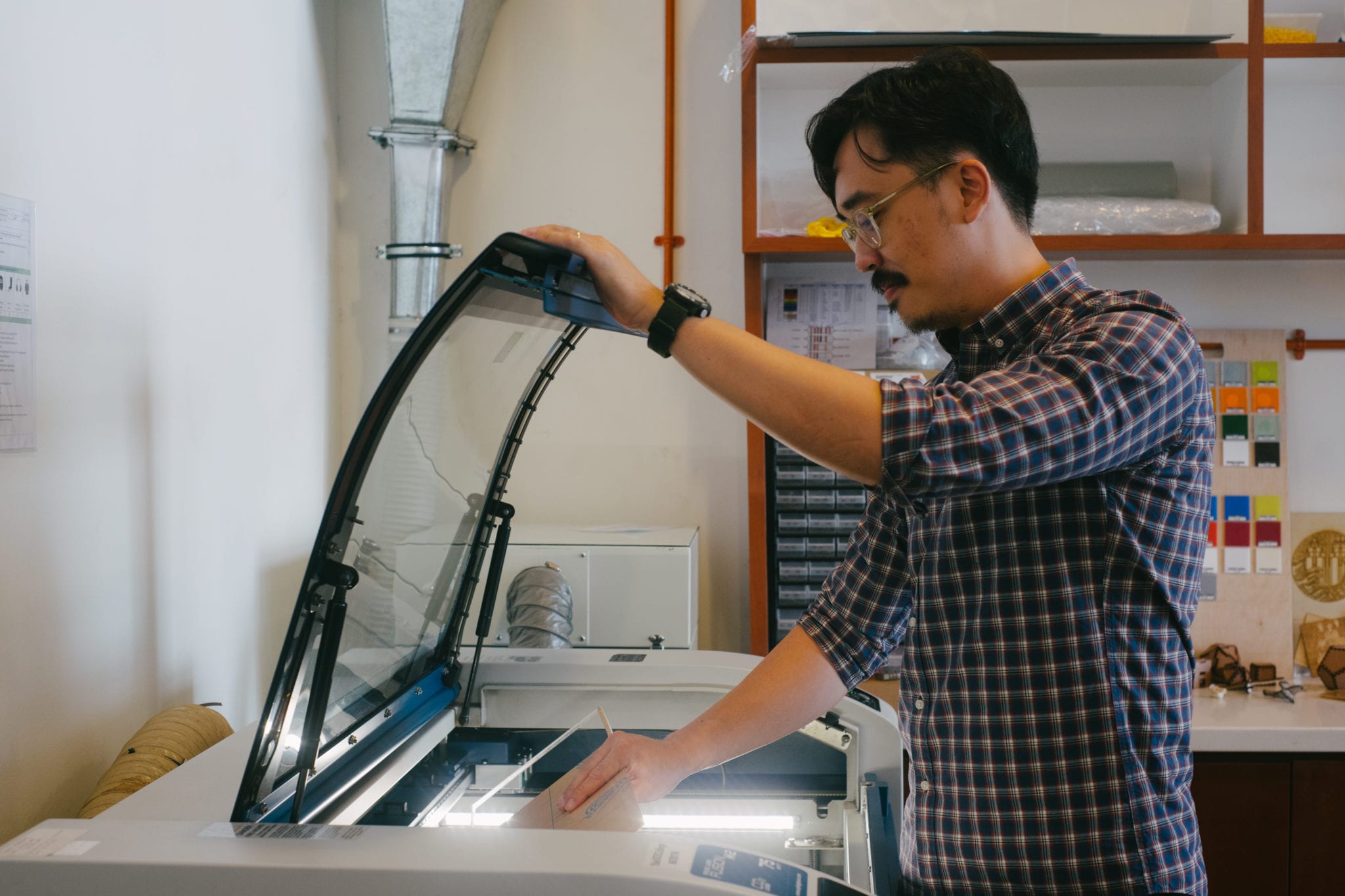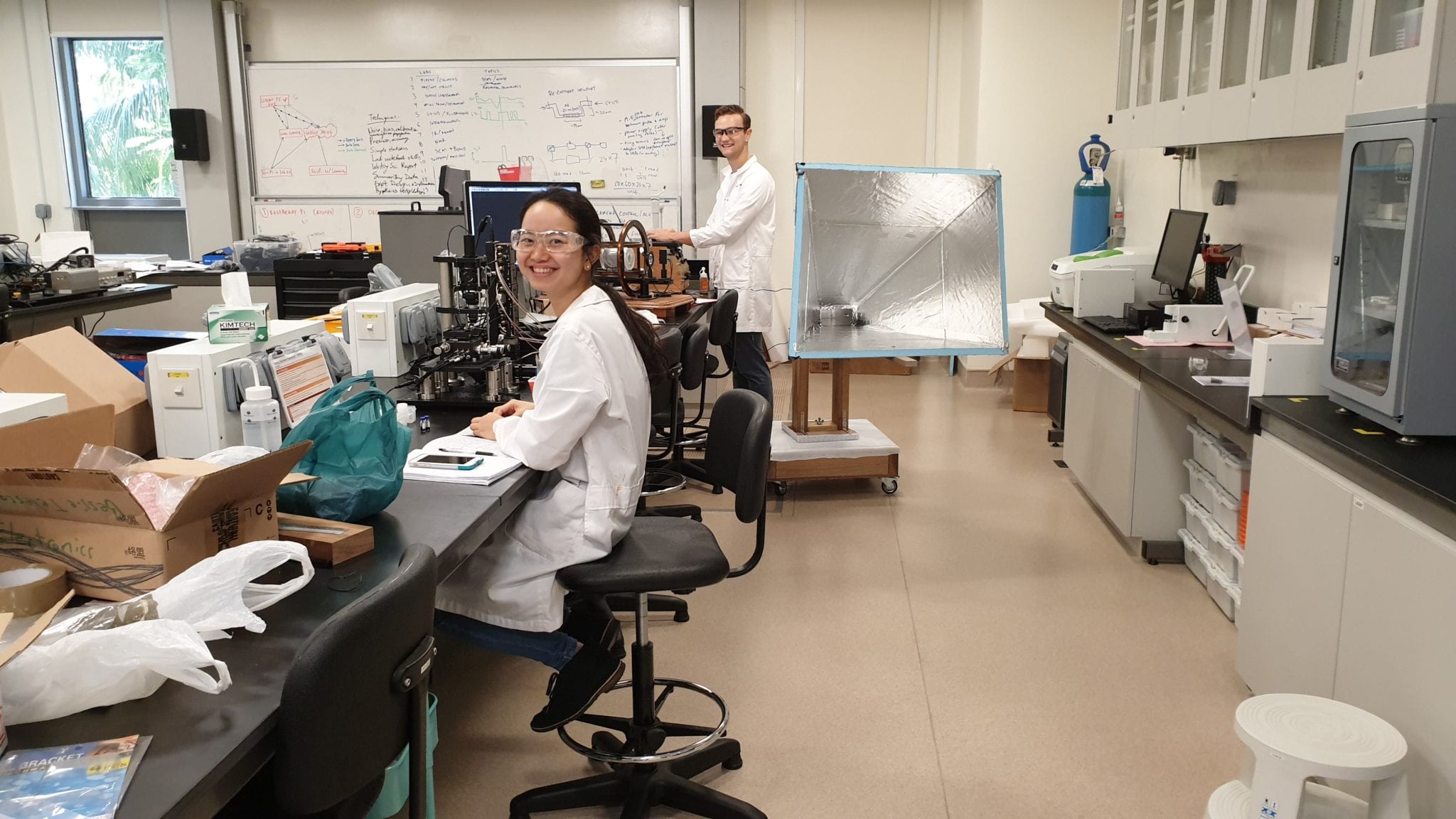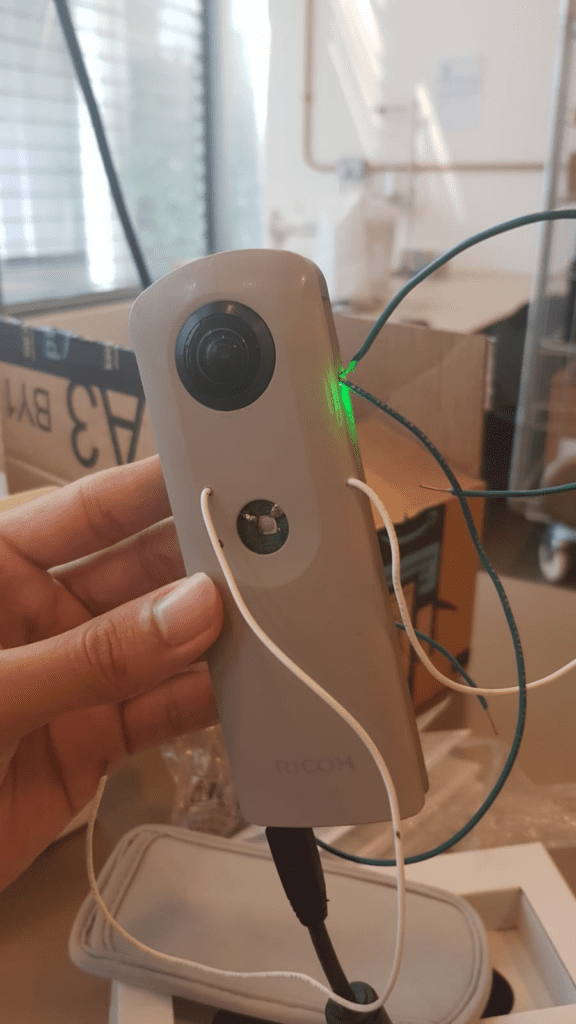ERT Arts facilitates science research at Yale-NUS
 Mr Niki Koh, Makerspace Specialist, demonstrates how to use the laser cutter. The Fabrication Studio also contains 3D printers, sewing machines, and soldering and tinkering stations. Students can hang out in a dedicated ‘Thinking Space’ to discuss their ideas. Image by Darren Ang for Yale-NUS College.
Mr Niki Koh, Makerspace Specialist, demonstrates how to use the laser cutter. The Fabrication Studio also contains 3D printers, sewing machines, and soldering and tinkering stations. Students can hang out in a dedicated ‘Thinking Space’ to discuss their ideas. Image by Darren Ang for Yale-NUS College.
As part of the Educational Resources & Technology (ERT) Department, the ERT Arts Office oversees all areas of arts development on campus. Not only does it manage arts spaces such as the performance hall and dance studios, it also provides consultancy services for student-led artistic projects.
However, what many might not know is that ERT Arts plays an important role in supporting the sciences on campus as well.
“When people hear the name ERT Arts, they assume that we only cater to projects that are creative and artistic. However, a major part of what we do is in fact supporting the sciences,” said Mr Gurjeet Singh, Senior Associate Director of ERT Arts.
The main avenue of support that ERT Arts offers the sciences is the Fabrication Studio, which comprises a wood shop containing various tools for carpentry and woodworking, and a Makerspace equipped with machinery including 3D printers and a laser cutter, solders for electronic parts, as well as a large format printer used to print scientific posters each semester.
The Fabrication Studio is open for students to use from 11am to 6pm, Monday to Friday, with Studio 4 (the Makerspace) opening till 11pm on Tuesdays and Thursdays. Not only do the facilities provide the equipment and materials for students and faculty to materialise their projects, a team of specialist staff is also present to offer their guidance.
“You really don’t have these opportunities elsewhere for such a small student body,” said Mr. Singh.
“What happens is that professors or students usually come in with a problem they want to solve. Sometimes they already have a solution in mind, but they don’t know how to execute it. That’s where we come in and work with them to fine-tune their solution and carry it out,” said Mr Niki Koh, who is the Makerspace Specialist at the Fabrication Studio.
One project he worked on was a collaboration with Assistant Professor of Science (Chemistry) Stanislav Presolski to 3D-print additional parts for a molecule model set used as a teaching tool. Another was a radio telescope built by Alexander Reaves (Class of 2021) as a Summer Research Project. The telescope will be used to measure light emitted from interstellar clouds of hydrogen in the disk of our galaxy. To build the telescope, Alexander worked closely with wood shop staff, who cut the pieces for the telescope’s base and helped him assemble it.
 Beatrice Chew and Alexander Reaves (both Class of 2021), students under the Summer Research Programme, pose next to the completed radio telescope. Image provided by Alexander Reaves.
Beatrice Chew and Alexander Reaves (both Class of 2021), students under the Summer Research Programme, pose next to the completed radio telescope. Image provided by Alexander Reaves.
Similarly, Ayrton San Joaquin (Class of 2022) used the tools in the Fabrication Studio to build a 360-degree camera which uses motion sensors to capture images of birds as part of his work with Senior Lecturer of Science (Life Sciences) Philip Johns.
He highlighted the importance of the assistance and training he received from the ERT Arts staff in completing this project:
“The staff were very helpful. Niki taught me how to use the dremel (a power tool for cutting and arguably the most dangerous tool in the Makerspace) to make holes in the plastic case. Ashley was there to help with storage and soldering tips.”
 The finished 360-degree camera built by Ayrton San Joaquin. He used the Fabrication Studio’s tools to solder the motion sensors to the camera and modify the plastic case. Image provided by Ayrton San Joaquin.
The finished 360-degree camera built by Ayrton San Joaquin. He used the Fabrication Studio’s tools to solder the motion sensors to the camera and modify the plastic case. Image provided by Ayrton San Joaquin.
Yet ERT Arts supports not only students, but faculty too. Assistant Professor of Science (Physics) Chelsea Sharon taps upon ERT Arts’ resources in teaching General Physics, bringing her students to the Fabrication Studio to build small electronics. According to Asst Prof Sharon, the hands-on experience not only helps reinforce students’ conceptual understanding of physics, but also encourages a sense of creativity and excitement.
“These hands-on experiences are also important for students to learn about the creative aspects of physics. It’s not uncommon for students to lose sight of the creativity and excitement of building new knowledge during the foundational pen-and-paper parts of physics, and the Makerspace is an excellent way for students to have fun with physics.”
Asst Prof Sharon says she plans to continue collaborating with ERT Arts in the future. “The Makerspace is an important collaboration point that exemplifies the overlap between these two broad disciplines. Physical Sciences certainly plans on using the Makerspace for future courses so students can work on creative small electronics projects.”





